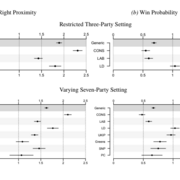Mauerer, Ingrid, and Annemarie Walter. 2000. “Taking Ballots Seriously: Heterogeneous Ballot Compositions and Vote Choice..”
See also:
Papers
mauerer-walter-2021.pdf305.95 KB
Abstract
In partially-contested multiparty elections, voters are confronted with different party choices, depending on their constituency. We present a computationally straightforward modeling approach that systematically integrates heterogeneous ballot compositions, which classical models neglect, into the voter utility functions. We illustrate the benefits of the approach in studying British spatial voting behavior, where previous studies tend to simplify the actual choice situation by modeling a single ballot composition, thereby ignoring a substantial part of the electorate. Using 2015 British Election Study data, we simultaneously consider up to seven parties, spread across eight unique ballots, and provide a fully-specified vote model. The results show that both spatial and tactical considerations depend on which party voters evaluate. Whereas spatial proximity substantially impacts voting for the large parties, we uncover the reversed pattern for tactical considerations. These party-specific effects are not found when neglecting ballot composition heterogeneity.
Last updated on 11/11/2021

